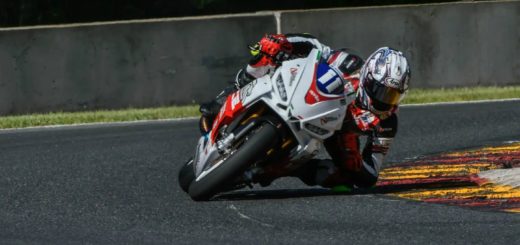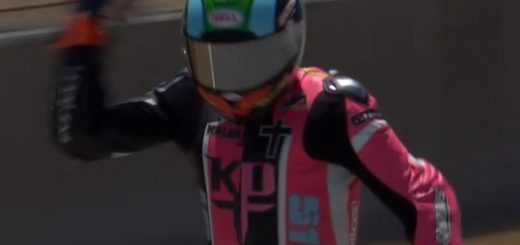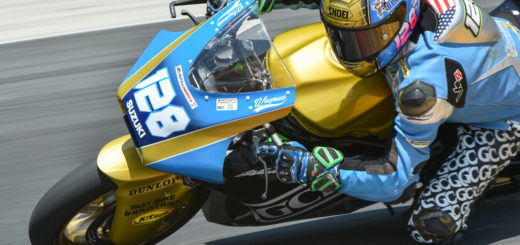MotoAmerica Twins 2023 – Part 2 – Yamaha R7 vs Aprilia RS660
This post has already been read 4196 times!
We are seven rounds into the 2023 twins cup championship and once again the two bikes at the pointy end are the Yamaha R7 and the Aprilia RS660. So before we dive into these two bikes, let’s take a look at the history of twins cup and how the class has developed into what it is today.
The Twins Cup started in 2018 and the main players were the Suzuki SV650 (2nd and 3rd generation) and the Yamaha FZ07/MT07. At first, participation in twins cup was light but by the end of the year, the grids were full and the class survived its rookie season. In 2019, the bikes on the grid and the teams took a step up. Team Hammer joined the class with 2 riders and the SV650 was allowed a 2mm overbore. Quarterly Racing ran a one rider program with Michael Barnes on the Ducati 797, and the grids were full starting at the first round. In 2020 COVID hit, and amazingly, the class continued to grow. In 2021 things got interesting. With absolutely no development time, the RS660 showed up and won the championship. In 2022, Yamaha made a huge push and made a big investment in twins cup with a large contingency program, with several teams receiving direct Yamaha support. Also, Yamaha used all of the R&D from their flat track program to produce a YMUS power up kit which greatly elevated the performance of the CP2 engine. For 2023, the twins cup grid is full of Yamahas and Aprilias with the odd SV650 and Kawasaki Ninja 650 entering here and there. In part 3 of this series, we will discuss what 2024 may look like but for now, we will look at the two main manufacturers fighting for the title in 2023.
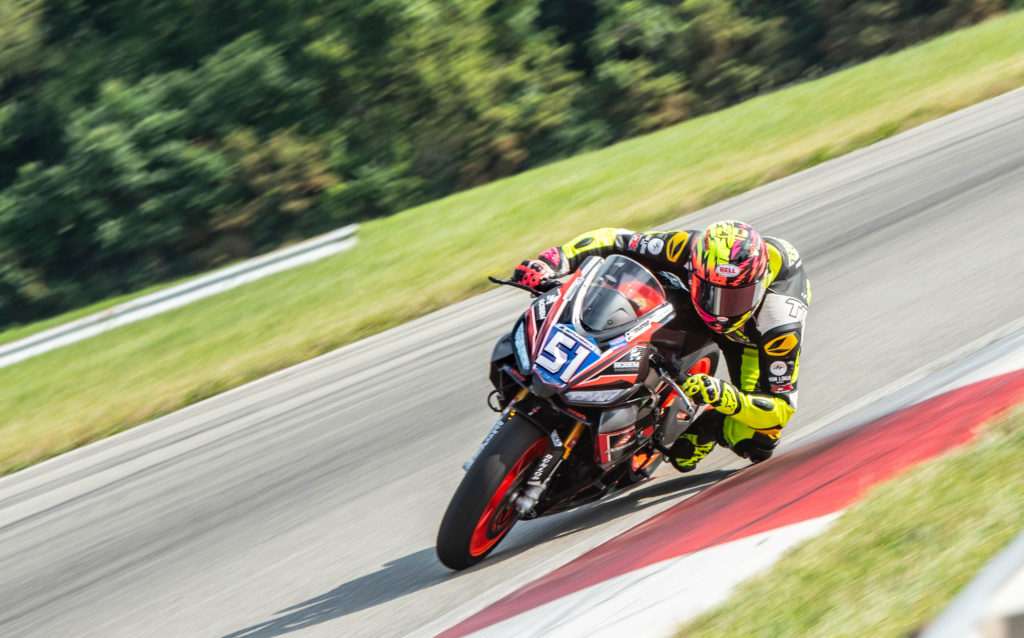
Aprilia RS660
The RS660 is a 659cc inline twin that uses a 270 degree offset crankshaft just like the Yamaha. It has an 81mm bore and 63.93mm stroke, and comes with a 13.5:1 compression ratio. Helping the 660 breathe is a set of 48mm throttle bodies which are controlled by a Magnetti Marelli 11MP ECU. The 660 chassis has 24.1 degrees of rake, 104mm of trail, and has a 53.9 inch wheelbase. Current MSRP for the 2023 RS660 is $11,499. The production RS660 was released in 2021. During homologation, balancing was a major concern with Moto America. A stock production RS660 puts out approximately 86hp depending on the dyno, which is 10 to 20 horsepower more than other bikes homologated for the class. In order to level the playing field, Moto America restricted the RS660 to stock pistons and stock connecting rods. Ironically, the RS660 was subject to a recall on 600 of the early 2021 models after a series of rod failures (everyone remembers Road Atlanta turn 1 crash) were linked to a batch of bad rods supplied by
the rod vendor. Following Yamahas investment in twins cup in 2022, front running Aprilia teams had to lean on the RS660 to compete with the acceleration advantage of the Yamahas. When this was done, rod failures occurred as the horsepower approached the century mark. After 2 years of competition, Moto America reversed their decision and for 2023, the RS660 may use aftermarket rods as long as the units weigh the same or more than stock rods. So, what does a Moto America spec RS660 make for horsepower in 2023? Well, it’s safe to say you need to have 100hp to be on the pointy end, and with technical regulations limiting the RS660 to stock pistons, as with all 4 stroke engines, the power is in the head.
Yamaha YZF-R7
The R7 is a 689cc inline twin that uses a 270 degree offset crankshaft. It has an 80mm bore, 68.6mm stroke, and comes with an 11.5:1 compression ratio. The R7 breathes through a set of 37mm throttle bodies which are controlled by a Denso ECU. The R7 chassis has 23.4 degrees of rake, 90mm of trail, and has a 54.9 inch wheelbase. Current MSRP for the 2023 R7 is $8,999. The CP2 engine first introduced in the FZ-07/MT-07 in 2015 has not changed and in stock form makes approximately 67hp. Current Moto America spec Yamahas are north of 100hp. To get there, the Yamahas on the twins cup grid have stock bore or custom 80.5mm high compression pistons to bring displacement up to 698cc, as well as cams, a ported head, rods, bored throttle bodies, and an airbox kit. Very recently, the R7 received a concession which allows R7 racers to close the deck in an effort to support the cylinders to prevent head gasket leakage.
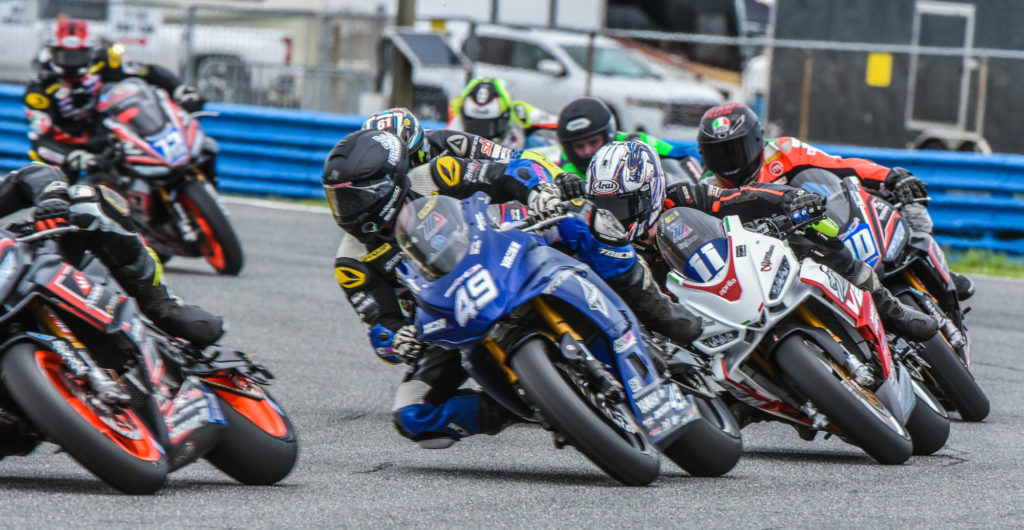
A direct comparison
Right now, the R7 and the RS660 are quite even when it comes to horsepower. After personally viewing dyno sheets from the front running Yamahas and Aprilias as well as analyzing trap speeds, it’s safe to say the horsepower at the pointy end is quite equal. What makes these bikes different are the chassis. The R7 is derived from the FZ07 commuter bike which was never designed to go around a race track, and this is quite evident by the stock chassis geometry. Yamaha did add bolt on cast plates to the R7 to add some rigidity but the chassis is still very similar to the original FZ07. To get the Yamaha chassis to perform, it requires adjustable triple clamps and a rear suspension link to get trail and swingarm angle numbers in the ballpark. Also, the tubular steel frame has a lot of flex and combined with slicks and racetracks with grippy new asphalt, seems to produce a lot of chatter. Looking at the chassis numbers on the Aprilia, it’s quite evident that the company from the small town of Noale spent quite a bit of time developing the RS660 on the racetrack. Although the RS660 was built with some cost cutting measures (it has no rear suspension link and the twins spar aluminum frame is in two pieces and is bolted together), the chassis works very well out of the box and is a proven Moto America race winner with stock chassis components. Analyzing the results of 2023, it appears that the Yamaha does well at point and shoot tracks with older asphalt, and the Aprilia does well at flowing tracks which requires the bike to be on the side of the tire for a long time
Pros and Cons
What does the Yamaha have going for it? Well, a healthy contingency program pays cash for results and if you’re a front runner, Yamaha has a lot of support available. Also, the Yamaha is a bit easier to work on and has a bigger dealer network with better access to spare parts. The cons of the Yamaha, it is difficult to set up, has a flexy chassis and requires a lot of expensive chassis parts. Also, it does not crash well and the frame bends quite easily. The pros of the Aprilia, horsepower out of the box, a chassis designed on the racetrack and sophisticated electronics. The cons of the Aprilia, no contingency, a smaller dealer network and gaining access to spare parts can quite difficult. It tends to run quite hot, and the sophisticated electronics can be very sensitive at times. Also, the front forks are easily bent in a crash. I want to make something clear, there is very little difference in cost when it comes to building these bikes for Moto America Twins Cup. It is incredibly pricey to build either of these bikes to be a frontrunner. Pick your poison!!!
Part 3 on the way.
This post has already been read 4196 times!

